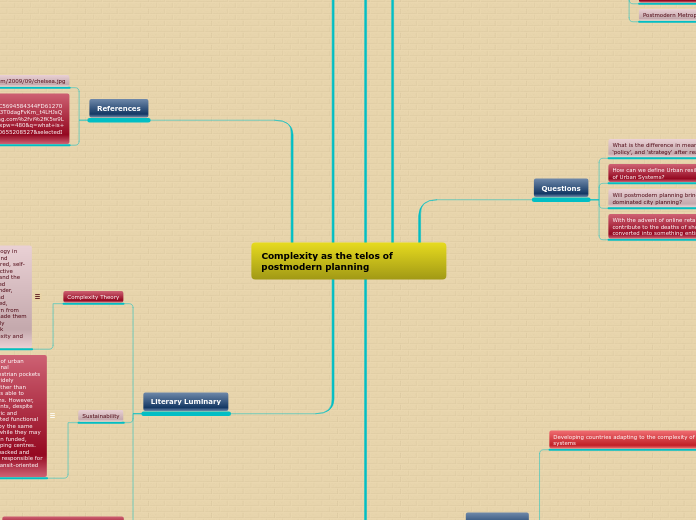Complexity as the telos of postmodern planning
Illustration
Illustration from the article
Illustration
Vocabulary Enricher/Word Wizard
Mechanistic system

Top-down System
Complexity Theory
Postmodern Metropolis
Questions
What is the difference in meaning of the terms 'planning', ‘policy’, and 'strategy' after reading the article?
How can we define Urban resilience considering the complexity of Urban Systems?
Will postmodern planning bring in a phase of corporate dominated city planning?
With the advent of online retail, will postmodern planning also contribute to the deaths of shopping centers that will be converted into something entirely different?
Connections
Developing countries adapting to the complexity of urban systems
All around the world the growth of cities has been very disproportionate to urbanization. Urban transition is something that unfolds in all developing countries starting from all different patterns and outcomes that usually never follow the right process. Although most of our knowledge on developing countries is explained through our history we have dealt with several misunderstandings. Through these misconceptions the growth of cities focuses on outcomes which start from rural to urban migration, and disregard the growing urban natural population increase. This has caused urban growth to isolate urban studies which prevents real theorization. During the 20th century the growth and development of cities have made an impact to economic advancement. They have taken manpower from the outside and used it towards goods and services that help to modernize agriculture. Although today in developing countries the growth of cities has become unbalanced from economic development which leads to rural urban migration. This eventually leads to population growth and higher rates of birth.
Starbucks
A recent example of post modernization is the world’s largest Starbucks that was built in Chicago. This four-story building is replacing what was once a Crate and Barrel location along the ‘Magnificent Mile neighbourhood.’ The bright and open window building was built in 1990, selling home goods and furniture. Having this Starbucks replace Crate and Barrel represents post modernization. The structure of the building resembles a very postmodern look, and the technology used in this building is far beyond the modern era. The on-site roasting of its special coffee beans as well as being around the culture and tradition of downtown Chicago. Having this Starbucks open has demonstrated “theatrical experiential shrines to coffee passion”
Market
An example in my own life would be the Red Deer market that happens every Saturday morning. The city came together to design an urban space that would only be used for this market which did not allow for chain stores to come in. The farmers market can be seen as a mean to sustain farming activity through their culture. It benefits for low-income consumers in the form of access to lower food prices. By doing so, they were able to allow for local artists to conserve the real culture of the neighbourhood.
Subtopic
Summary

Complex City
References
Literary Luminary
Complexity Theory
“Complexity theory represented a scientific methodology in support of what they had long inductively observed and previously articulated, cities were complex, multilayered, self-organised and not readily understood by way of reductive formulas. Lynch argued that the best way to understand the city was as an ecosystem constructed by the dispersed conscious thinking of autonomous inhabitants. Alexander, Alexander et al. , Hillier and Hanson, Lynch, Relph and Norberg-Schultz observed that cities were multilayered, evolving, learning and complex, with a dynamic drawn from vernacular pluralism and endogenous activity. This made them evolving, messy and unpredictable but vital and highly dynamic. In their analyses, they professed a clear link between the endogenous dynamic of the city, complexity and urban form.”
Sustainability
“Since the rise of sustainability as a major goal of urban planning over the last few decades, neo-traditional development in the form of urban villages, pedestrian pockets and transit-oriented developments have been widely championed and facilitated on environmental rather than social or aesthetic grounds, as sustainable forms able to reduce vehicle miles travelled and CO2 emissions. However, actual new urban or transit-oriented developments, despite their emulation of the form of the traditional civic and neighbourhood commons, have not always created functional complexity. Instead, they are often dominated by the same chain stores found anywhere in suburbia, and, while they may look like a traditional town centre, they are often funded, owned and managed along similar lines to shopping centres. In the late capitalist city, private corporations, backed and facilitated by local growth machines, have been responsible for the planning, development, and marketing of transit-oriented and new urban developments.”
Postmodern theory vs Complexity theory
“Its attraction begins with its basic principles, which are the antithesis of modernist values, such as order, efficiency, logic and predictability. Instead, complex adaptive systems have a dynamic of messy, unmediated evolution and control by dispersed bottom-up self-organisation Young (2008) argues that postmodern urban planning begins with an understanding and love of complexity, while Portugali (2011) claims that complexity theory has become in a couple of decades ‘an established interdisciplinary research domain engaging urban geographers, planners, urban designers, regional scientists, mathematicians, physicists and others”.
